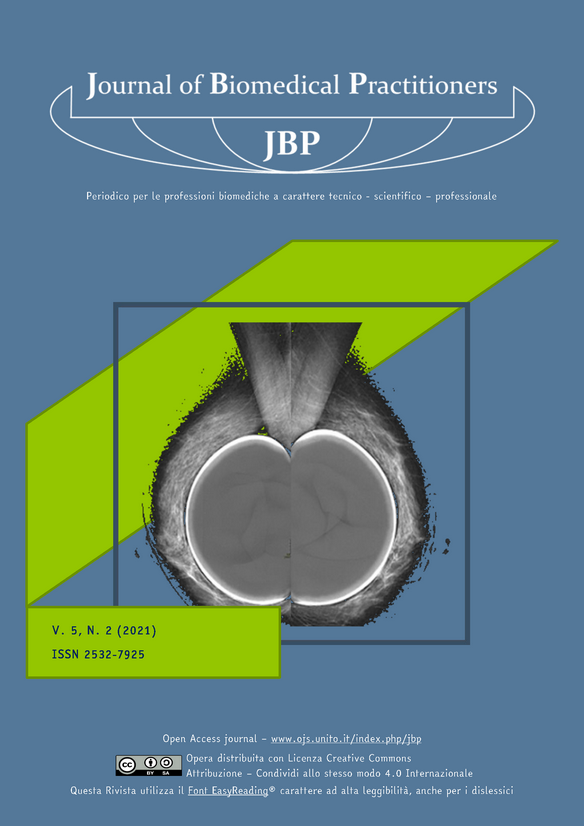The impact of the SARS-CoV-2 pandemic on the workloads of UPMC advanced radiotherapy centers in Italy
Contenuto principale dell'articolo
Abstract
GOALS
The Advanced Radiotherapy Centers of UPMC San Pietro FBF of Rome (CC#1) and UPMC Villa Maria of Mirabella Eclano (CC#2) conducted a study to review variations in department workloads and workflows experienced during the pandemic. The potential relation between these variations and the new procedures introduced to prevent and contain the COVID-19 infection was also studied.
MATERIALS AND METHODS
The data used were obtained from reports present in the ARIA® system (v. 15.1 Varian Medical Systems, Palo Alto, CA, U.S.A.). To examine the workloads was used the Downtime, an indicator that directly quantifies the inactivity of the department, derived from the ratio between the daily stand-by time of the LINACs (TrueBeam STx®, Varian Medical Systems, Palo Alto, CA, U.S.A.) and the mean number of treatments performed every day. In order to examine the workflows and possible delays, we measured the time between the treatments ("Therapy intervals").
RESULTS
The Downtime average at CC#1 slightly increased from 3.1% in 2019 to 3.8% in 2020. However, the monthly analysis shows significant reduction (March-April-May) and increase (November-December) peaks. At CC#2, the 2020 Downtime trend was fairly consistent (average value: 3.3%), with an increase during the first wave of the pandemic.
The "5-10 min" Therapy intervals at CC#1, reviewed comparing the March-April-May 2020 quarter with 2019, were higher in the first months and lower in May; the "10-15 min" intervals were stable; the ">20 min" intervals slightly increased in March 2020. At CC#2, the trend in 2020 decreased during the months of higher health care emergency and increased during the summer months.
CONCLUSIONS
The fact that the trends of the indicators show peaks only during the periods of major health care emergency indicates an impact of the pandemic, both on the workload and on the workflow. However, they also highlight the staff's ability to rapidly adapt to the new procedures, without affecting the overall performance of the both centers.
Downloads
Dettagli dell'articolo
Gli autori mantengono i diritti sulla loro opera e cedono alla rivista il diritto di prima pubblicazione dell'opera, contemporaneamente licenziata sotto una Licenza Creative Commons - Attribuzione che permette ad altri di condividere l'opera indicando la paternità intellettuale e la prima pubblicazione su questa rivista.
Riferimenti bibliografici
[2] COVIDSurg Collaborative, Elective surgery cancellations due to the COVID‐19 pandemic: global predictive model-ling to inform surgical recovery plans, British Journal of Surgery; 2020
[3] COVID-19's Impact on Radiation Oncology. Initial Results of a Nationwide Physician Survey, Available online at https://www.astro.org/ASTRO/media/ASTRO/News%20and%20Publications/PDFs/ASTROCOVID19Survey1-ExecSummary.pdf; 2020
[4] Atun R. et al. Expanding global access to radiotherapy. The Lancet Oncology; 2015
[5] Slotman BJ, Lievens Y, Poortmans P. Effect of COVID-19 pandemic on practice in European radiation oncology centers. Radiother Oncol.; 2020
[6] Rugge M, Zorzi M, Guzzinati S., SARS-CoV-2 infection in the Italian Veneto region: adverse outcomes in patients with cancer. Nature Cancer; 2020
[7] Ministero della Salute, Raccomandazioni per la gestione dei pazienti oncologici e oncoematologici in corso di emergenza da COVID-19, Avaiable online at http://www.trovanorme.salute.gov.it/norme/renderNormsanPdf?anno=2020&codLeg=73635&parte=1%20&serie=null
[8] Joint Commission International, Joint Commission International Accreditation Standards for Hospitals. 7th Edition; 2020
[9] World Health Organization Coronavirus Disease (COVID-19), Infection prevention and control guidance, Avaiable online at https://www.who.int/teams/risk-communication/health-workers-and-administrators/infection-prevention-and-control/guidance
[10] Gruppo di Lavoro ISS Prevenzione e Controllo delle Infezioni, Indicazioni ad interim per un utilizzo razionale del-le protezioni per infezione da SARS-COV-2 nelle attività sanitarie e sociosanitarie (assistenza a soggetti affetti da covid-19) nell’attuale scenario emergenziale SARS-COV-2, Rapporto ISS COVID-19 n. 2/2020 Rev.
[11] American Society for Radiation Oncology, Covid-19 FAQs; 2020 Avaiable online at https://www.astro.org/Daily-Practice/COVID-19-Recommendations-and-Information/COVID-19-FAQ-Updates/COVID-19-FAQs
[12] Associazione Italiana di Radioterapia Oncologica, Documento di indirizzo per la valutazione e la gestione del ri-schio dei pazienti e degli operatori dei reparti di radioterapia oncologica in corso di diffusione del COVID-19; 2020, Avaiable online at https://www.radioterapiaitalia.it/wp-content/uploads/2020/03/v-2-Documento-AIRO-COVID-19-24-03-2020.pdf
[13] Regione Lazio, Registro Ufficiale U.0963319.10-11-2020, Indicazioni sull’esecuzione di test antigenico agli ope-ratori sanitari; Prot. N. 162740/2020
[14] Regione Campania, Piano Regionale di potenziamento delle attività diagnostiche dei casi COVID-19 e di screening degli operatori sanitari e della popolazione maggiormente esposta in Regione Campania; Aggiornamento luglio 2020

